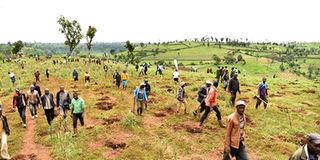State to fence Maasai Mau Forest to keep off encroachers

Residents digs holes in Maasai Mau Forest on November 1, 2019 for planting of trees after illegal settlers left. The government has announced plans to fence off the key water tower. PHOTO | CHEBOITE KIGEN | NATION MEDIA GROUP
What you need to know:
- The government is in the process of setting aside funds to facilitate the fencing of at least 50 kilometres of the forest.
- The State also remains cagy on details about the project and whether the fence will be extended to cover the entire Mau Forest complex.
- Last week, Environment CS Keriako Tobiko launched an initiative to plant millions of trees in the forest.
Days after the last group of illegal settlers who had encroached the Maasai Mau Forest were kicked out, the government has announced plans to fence off the key water tower.
The fence, which, according to the authorities, will be in place by January next year, will prevent future encroachment and destruction of the forest.
Rift Valley Regional Coordinator George Natembeya on Monday revealed that apart from the ambitious initiative by the State to plant at least 10 million trees in the forest, as part of the restoration process, plans are underway to fence off the 46,000-hectare forest.
MARK BOUNDARIES
“The government surveyors are on the ground. The intention is to place permanent beacons around the forest, to mark its boundaries, before the Kenya Water Towers Agency erects an electric fence around it. We are almost done with the beacons and the fence will be up by January 2020,” said Mr Natembeya.
A source at the Ministry of Environment and Forestry revealed to the Nation that the government is in the process of setting aside funds to facilitate the fencing of at least 50 kilometres of the forest out of the expected 119 kilometres.
“The process is almost complete to secure the water tower and avoid future encroachments. This will happen very soon after tendering is complete,” said the source.
TASKFORCE REPORT
Plans to fence off the entire expansive Mau Forest Complex were first mooted in 2009 after a report by then Prime Minister Raila Odinga dubbed ‘Prime Minister Raila Odinga's Task Force on the Conservation of the Mau Forest Complex’ released in March 2009 made far-reaching recommendations among them fencing off the forest.
So far, with the plans to fence off the Maasai Mau Forest in top gear, the government is yet to declare the amount of money it will use for the purpose.
The State also remains cagy on details about the project and whether the fence will be extended to cover the entire Mau Forest complex or not.
SETTLE EVICTEES
The plans to fence the Maasai Mau Forest come hot in the heels of plans by Rift Valley leaders to raise Sh84 million to buy land for over 70,000 Mau Forest evictees, even as they threatened to take the matter to the International Criminal Court (ICC) to seek redress.
The leaders among them senators Aaron Cheruiyot (Kericho), Christopher Lang’at (Bomet), MPs Johana Ng’eno (Emurua Dikirr), Beatrice Kones (Bomet East), Brighton Yegon (Konoin) Japhet Mutai (Bureti) and Joseph Tonui (Kuresoi South) are supporting the funds drive.
Others who have joined the push include Governors Jackson Mandago (Uasin Gishu), Stanley Kiptis (Baringo), Paul Chepkwony (Kericho), Hillary Barchok (Bomet) and Stephen Sang (Nandi).
The planned funds drive is intended for buying about 120 acres for the affected families as a permanent solution for what the leaders termed as a humanitarian crisis is sought.
PLANT TREES
Last week, Environment Cabinet Secretary Keriako Tobiko launched an initiative to plant millions of trees in the forest.
The project – dubbed ‘Restore Mau, Save the Mara-Serengeti Ecosystem, Save Lives’ — saw modern technology being used by the Kenya Forestry Research Institute (Kefri) to sow 1.5 million seedlings, with an aircraft being used for the aerial seeding.
Mr Natembeya has termed the restoration of the section of the forest a success, saying that most of the illegal settlers honoured the government’s 60-day notice to leave the forest.
The ultimatum for people to voluntarily move out lapsed on October 30.
“Majority of the settlers left the forest voluntarily, whereas those who remained were assisted by government agencies to get out of the water tower. The next phase will now entail fencing and restoration of the forest through tree planting,” said Mr Natembeya.




